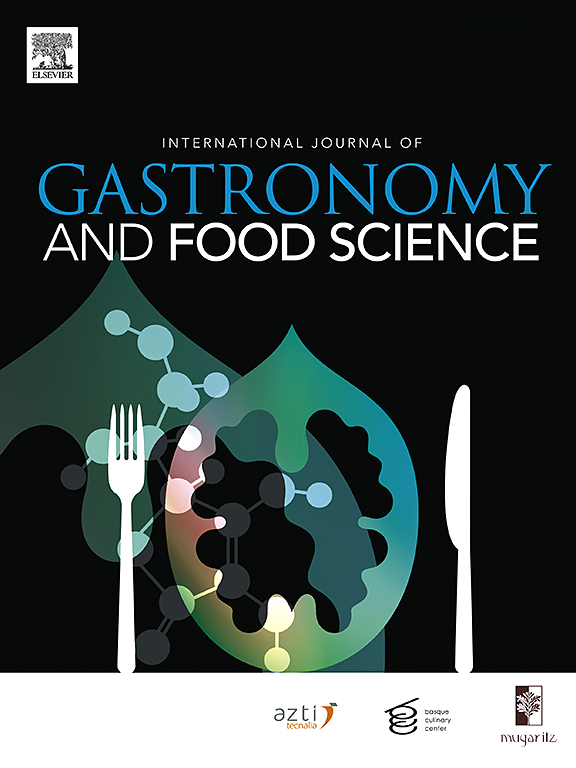火龙果酱的配方和特性:质量、可接受性和微生物稳定性
IF 3.2
2区 农林科学
Q2 FOOD SCIENCE & TECHNOLOGY
International Journal of Gastronomy and Food Science
Pub Date : 2025-05-08
DOI:10.1016/j.ijgfs.2025.101196
引用次数: 0
摘要
本工作旨在用火龙果“de mayo”配制两种酱汁(甜的和辣的),并评估它们的物理化学和感官特性、稠度、粘度和近端成分。此外,测定了四周的微生物稳定性。浓缩火龙果果肉(70°白利度),并用于制备甜辣酱。两种酱料的pH值、白锐度、颜色、稠度、粘度、近似成分和感官属性(风味、质地和外观)都通过验收测试来确定。该酱料pH≤4.3,°白锐度在21 ~ 24之间,色泽深红色,稠度较好。测试感官属性的平均得分为~ 4.5分(介于“喜欢”和“非常喜欢”之间),两种酱料的可接受程度没有显著差异。在35℃条件下加热2周后,总中温嗜氧好氧菌(TMAB)、总大肠菌群、酵母和霉菌的数量保持在10 CFU/g左右,而在甜酱中发酵28天后,酵母和霉菌的TMAB分别达到2.1 log和1.7 log,辣酱中的TMAB数量较低。火龙果作为酱汁的基础成分,为保存和食用火龙果提供了另一种选择。本文章由计算机程序翻译,如有差异,请以英文原文为准。
Formulation and characterization of pitaya-based sauces: Quality, acceptability, and microbial stability
This work aimed to formulate two sauces (sweet and spicy) using pitaya “de mayo” and evaluate their physicochemical and sensory properties, consistency, viscosity, and proximal composition. In addition, microbial stability was determined for four weeks. Concentrated pitaya pulp (70 °Brix) was obtained and used to prepare sweet and spicy sauces. pH, °Brix, color, consistency, viscosity, proximal composition, and sensory attributes (flavor, texture, and appearance using an acceptance test) were determined in both sauces. pH of the sauces was ≤4.3, °Brix was between 21 and 24, the color was deep-red, and the consistency was reasonably good. Averages scores for the tested sensory attributes were ∼4.5 (between “like” and “like a lot”), and no significant differences in the acceptability level for both sauces were observed. Total mesophilic aerobic bacteria (TMAB), total coliforms, and yeast and mold remained <10 CFU/g after 2 weeks at 35 °C while after 28 days, TMAB reached 2.1 log and 1.7 log yeast and mold in sweet sauce and lower counts in spicy sauce. Pitaya, as a base ingredient in sauces, provides an alternative for preserving and consuming it.
求助全文
通过发布文献求助,成功后即可免费获取论文全文。
去求助
来源期刊

International Journal of Gastronomy and Food Science
Social Sciences-Cultural Studies
CiteScore
5.30
自引率
10.50%
发文量
170
审稿时长
45 days
期刊介绍:
International Journal of Gastronomy and Food Science is a peer-reviewed journal that explicitly focuses on the interface of food science and gastronomy. Articles focusing only on food science will not be considered. This journal equally encourages both scientists and chefs to publish original scientific papers, review articles and original culinary works. We seek articles with clear evidence of this interaction. From a scientific perspective, this publication aims to become the home for research from the whole community of food science and gastronomy.
IJGFS explores all aspects related to the growing field of the interaction of gastronomy and food science, in areas such as food chemistry, food technology and culinary techniques, food microbiology, genetics, sensory science, neuroscience, psychology, culinary concepts, culinary trends, and gastronomic experience (all the elements that contribute to the appreciation and enjoyment of the meal. Also relevant is research on science-based educational programs in gastronomy, anthropology, gastronomic history and food sociology. All these areas of knowledge are crucial to gastronomy, as they contribute to a better understanding of this broad term and its practical implications for science and society.
 求助内容:
求助内容: 应助结果提醒方式:
应助结果提醒方式:


